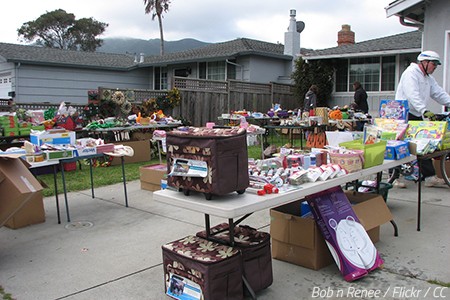Most of the people who are getting ready to move out of their homes don’t always stick a High Priority label to the job of packing books. Such an obvious act of underestimation may be the direct result of people
- having too many things on their minds to worry about packing and moving their books,
- thinking that packing books for a move is the easiest move-related task in their calendars, or
- owning too few books to really be intimidated by the book packing job ahead of them.
 While it’s true that packing books for moving is relatively easier than packing kitchen plates and glasses for a move, you still need to know the basic book packing principles and safety rules to prevent any damage to your favorite volumes and prolong their shelf life.
While it’s true that packing books for moving is relatively easier than packing kitchen plates and glasses for a move, you still need to know the basic book packing principles and safety rules to prevent any damage to your favorite volumes and prolong their shelf life.
But here’s the thing: moving house is a notoriously chaotic period in life when even seemingly simple and straightforward tasks can go terribly wrong.
The next 10 packing steps will show you the best way to pack books for moving.
Step 1. Optimize your book collection
Books cannot be broken easily like kitchen plates or glass vases, so what’s all the fuss about packing and moving books?
Well, when packed together inside a box, books become super heavy and that weight alone can cause a number of problems for you on moving day.
A single book page is almost weightless, one book is not really heavy, get 5 books together and things are starting to feel differently. Cram 10 books in one tight place and you’ll understand why moving books could prove to be harder than you expected.
And since the final moving price will be based primarily on the move distance and the total shipment weight, you should seriously consider lowering that overall weight any way you possibly can.
Do you really need to take all the books you own?
First and foremost, go through your book collection book by book and select only the copies you must have with you at all costs – prized collections, valuable books, favorite books, and gifts from dear friends will surely make it to your new home.
Step 2. Sort and group your books
Time can kill the value of books – either literally or figuratively speaking, or maybe even both.
While reassessing your book collection, you may find out that some of your books have been seriously damaged with time, especially if they have not been properly stored. Other copies may have lost the original worth they had when you first bought them.
Either way, it’s time to sort out your books into two large piles: TAKE and LEAVE BEHIND.
Also, it’s important that you group the books you’re moving by size so that they can fit nicely into the book boxes. Not surprisingly, the more books you own, the more you’ll realize how many different sizes they come in.
So, find the time to organize your volumes by size because that’s definitely going to help you pack your books faster and safer when you get to the book packing moment. Also, having your copies neatly sorted out and separated by size will speed up the unpacking process as well.
Below, we’ll give you great tips for packing books when moving house (the TAKE pile) but let’s first say a few words about what you should do with the LEAVE BEHIND stack.
How to Make a Home Inventory When Moving
Step 3. Decide what to do with unwanted books

Pass on good books to caring hands.
It’s never easy to decide which books you’ll have to leave behind. Yes, it can be very tempting to hold onto every book you have – if you happen to have a modest book collection, you might as well do it.
However, you should always remember that books are heavy and hauling a massive collection to a new home can cost you too much money.
So, what are your options when it comes to finding your unwanted books a new home?
- HAVE a garage sale if the weather is fine and you have enough time to organize the event. Moving sales are an excellent way to get rid of unwanted stuff – books in this particular case – and to earn a bit of extra money to cover some of the moving expenses.
- INVITE your friends over to your place and let them go through the LEAVE BEHIND pile of books. If they like any books, they can have them, no questions asked. This way, you’ll know that some of the books you used to own are now in good hands and in good homes as well.
- DONATE to charitable organizations all the books you won’t ever need again but are still worthy of being read and appreciated by other people. Where to donate used books? Check whether local libraries, hospitals, schools, nursing homes, or charity shops in your town or city will be willing to take the books you’re not taking with you.
- RECYCLE any paper copies that are too worn out, damaged, or worthless to be enjoyed by anyone but your local recycling center.
How to Get Rid of Stuff Before Moving
Step 4. Get proper book packing supplies
Even though packing books for a move may not the toughest job in your packing calendar, you’re still going to need the right packing materials to keep untimely damage away from your favorite volumes.
To finish your book packing task quickly and to avoid time-wasting interruptions, you should get your hands on:
- Book boxes. These cardboard boxes are not any special type of moving containers – rather, they just happen to meet 3 major requirements: 1) they are extra strong because they are made of thick cardboard, 2) they are small boxes with usual dimensions of 20’’ x 11’’ x 11’’ (medium-sized boxes should also do fine), and 3) they are perfectly clean, dry, and free of any signs of pre-existing damage.
- Packing paper. You’ll need clean and soft packing paper in order to pack valuable books, as well as to use as effective separators between rows of books already arranged in boxes.
- Newspapers. Newsprint is the ideal filling material – abundant and free of charge.
- Packing tape. Get at least 2 rolls of high-quality packing tape as it will also be used for additional reinforcement of book boxes.
- A marker pen. Label your packed boxes properly to make things easier for you upon arrival in the new home. /How to label moving boxes like a pro/
Where to Find Free Packing Materials: Free is Always Cheaper
Step 5. Prepare book boxes for increased efficiency
Before you can begin packing the pre-sorted and pre-grouped books into cardboard boxes of the right size – the best boxes for packing books, let’s list the steps you need to take to make sure the moving containers are 100% ready for use.
Here are the main 3 steps to prepare the cardboard boxes you’ll use to transport your books:
- TAKE a closer look at the boxes you plan to use for transporting your books. Inspect each book box carefully and make sure none of them is damp or has holes, tears, or other signs of excessive wear. Remember that books are too heavy to be moved in unreliable packing boxes.
- APPLY an extra layer of packing tape to the bottom of each book box to ensure that no moving container will break under the considerable weight. Also, use tape to reinforce all side seams of the cardboard boxes too.
- PLACE a couple of clean sheets of packing paper on the bottom of each container to create an initial insulating layer.
How Many Moving Boxes Do You Need?
Step 6. Use the best way to pack books for moving

Packing books is always more fun when a dear friend is willing to help.
The next few steps will teach you how to pack books in moving boxes so that you won’t have any accidents during the move itself. Ultimately, you will want to open up the book boxes after arriving in your new house or apartment and find the volumes exactly the way you have packed them.
- BE mindful that valuable books should be wrapped individually in soft packing paper. If you happen to own a few books of great sentimental value, you must keep them with you during the entire move.
- CHOOSE among 3 different ways to arrange books in boxes: upright, flat, and spine down.
- Upright. Arrange the books standing upright so that their open parts are facing the box sides. This is the way you would usually see books neatly arranged on bookshelves. Do not pack books with their open sides facing the inside of the book box.
- Flat. This is a very safe way of packing books in moving boxes – you just stack them along the box sides. Don’t forget to place the heavier copies first and then arrange the lighter ones on top of them.
- Spines down. This is the least recommended way to pack books in a box but if you decide to use it for some reason, always arrange the books with their spines facing the bottom of the moving container. DON’T do it the other way round – the book spines facing you – because you’ll risk damaging the bindings of your books forever.
- SELECT the book packing method that seems the quickest and easiest for you, and then stick with it until the end.
- AVOID arranging books too tightly one next to the other because that could cause you to damage a copy while you’re trying to take it out of the box upon arrival.
- PLACE a couple of sheets over the books and start a second row of books, should the box allows it, the moment you finish packing one row. The main idea is to always try and keep the pages of different books from touching in a direct way.
- FILL any large gaps inside the box with crumpled pieces of newspaper when you’re done packing books for shipping. This will ensure that no printed works shift inside the container during the trip.
- PLACE one final sheet of clean packing paper on the very top, then close the lids of the book box, and tape it securely.
- USE your black marker to label the boxes you’ve already packed – write BOOKS on at least two sides and mark the destination room.
Top 20 Packing Tips for Moving
Step 7. Pack books for storage
You may wish to pack some of your books for storage – that is, to place several book-filled boxes in storage once you reach the new home.
There are a couple of main reasons why you may NOT want to unpack your book boxes shortly after you reach the new place:
- there’s not enough space for all the books you’re taking with you,
- you’ve moved to temporary housing and expect to move again in the near future.
Here are the extra steps you should take when packing books for storage, regardless of whether it’ll be short-term storage or long-term storage for your valuables volumes:
- Wrap each individual book in soft packing paper as the initial layer of protection against dust and dirt.
- Wrap each paper-wrapped book in plastic wrap (stretch wrap, Saran wrap) over the initial layer of wrapping paper. This is the best way to pack books for storage because your precious books will also stay protected against possible moisture in the storage area.
The rest of the steps for packing books for storage remain the same as the steps for packing books for moving.
15 Tips for Packing Your Things for Storage
Step 8. Pack heavy books in rolling suitcases
Using strong cardboard boxes to pack books for moving is the classic approach that won’t go out of fashion anytime soon – it’s the book-packing method that people automatically think of whenever they have to transport their book collections to a new address.
However, packing books in moving boxes has two major disadvantages:
- the cardboard containers are still susceptible to damage and
- the book-filled boxes need to be either carried around on hand or wheeled out by being stacked on a moving dolly which will additionally make things more laborious and time-consuming.
What if you could use much stronger and bigger moving containers equipped with their own wheels? Actually, you can.
The best way to pack heavy books for moving is to transport them in travel suitcases that have small sturdy wheels at the bottom. The great news is that rolling suitcases are built to carry substantial loads so you can be sure that the heavy books you’re moving will be perfectly safe there.
So, if you own travel suitcases with wheels at the bottom, then take full advantage of them by filling them up with the heaviest books you can find in your TAKE pile. To pack books in a suitcase is pretty easy and quite straightforward – you don’t even have to label it once you’re ready.
Step 9. Follow safety rules when packing books

Packing books is not overly complicated but you still need to follow some basic packing and safety rules.
Knowing how to pack books when moving house is all about keeping in mind a number of safety tips.
Remember that books can still be ruined if you fail to follow some basic rules for packing books for a move:
- KEEP the weight of a single book box under 40 pounds. Again, books are heavier than you think.
- USE small to medium-sized boxes for packing books properly.
- DOUBLE-TAPE the seams of book boxes as a precaution, even when the containers are brand new.
- PLACE the heaviest books on the bottom of a cardboard box, always.
- USE extra care when packing valuable books – antique books or rare books. For best results, wrap them up in soft packing paper and transport them yourself in a special prized-collection-of-first-editions box.
20 Moving Safety Tips: Stay Safe When Moving
Step 10. Use caution when loading book boxes
Don’t underestimate the task of loading your book boxes into the moving truck or in your own car. As a rule of thumb, you shouldn’t let your guard down even when you’re one final step from crossing the finish line.
Here are a few safety tips for loading up your books into a moving vehicle:
- SPREAD OUT all book boxes on the bottom of the truck to eliminate the risk of a book-filled container toppling over during transit.
- DO NOT STACK book boxes on top of each other. Book-filled boxes are always heavy and if accidentally tipped, they can get damaged or cause damage to other household items inside the storage space of the vehicle. Or they can crush whatever’s underneath them.
Despite these great tips for packing books for moving, if you still have doubts that you may not be able to pack and move your books on your own, then get professional packers and movers to take care of your valuable book collection for you.
The post How to Pack Books for Moving: 10 Steps to Pack by the Book appeared first on The Moving Blog.







